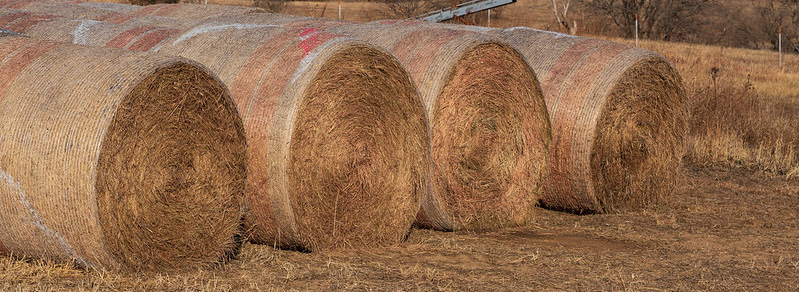
Chopped plastic on round hay bales can form a ball in a cow’s gut that will accumulate over time and can in some cases lead her to die, say experts at Kansas State University. | Download photo
Cattle Chat: The risks of offering wrapped hay bales to cattle
K-State beef cattle experts explain why cows need to be fed hay free of wrapping material
At a glance: K-State Beef Cattle Institute experts share reasons for taking the wrapping off the hay bales before offering the hay to the cows.
More information:
Bob Larson,785-532-4257, rlarson@vet.ksu.edu
Phillip Lancaster, 785-532-6323, palancaster@vet.k-state.edu
Brian Lubbers, 785-532-4012, blubbers@vet.k-state.edu
Related: Beef Cattle Institute Cattle Chat
Oct. 29, 2024
By Lisa Moser, K-State Research and Extension news service
MANHATTAN, Kan. – When driving in Kansas, it is easy to spot big, round hay bales that are wrapped in plastic and ready to be fed to cattle. When it is time to feed the bale, some producers put the hay with the wrap on in a grinder and chop it up together, while others choose to remove the wrap before offering free choice hay to the herd.
Which way is best for the cows? That is a question that the experts at Kansas State University’s Beef Cattle Institute answered on a recent Cattle Chat podcast.
The question came from a producer who discovered that one of his cows who died had a ball of plastic in her gut that likely came from eating the bale wrap and caused her to have a blockage that ultimately led to her death.
“Even chopped plastic can form a ball in a cow’s gut that will accumulate over time and can in some cases lead her to die,” K-State veterinarian Bob Larson said.
This has to do with how feed moves through the rumen, which is a chamber in the cow’s stomach, K-State beef cattle nutritionist Phillip Lancaster said.
He shares that as the feed passes through the rumen in the normal digestion process of a beef animal, there is a liquid layer that the feed must sink through to get to the next chamber – the reticulum.
“The particles have to be dense enough to sink into the reticulum, but plastic pieces are very light so they float and can accumulate in the rumen over time,” Lancaster said.
He added that death can happen when the plastic ball acts like a plug either preventing gas release or passage down the digestive tract.
Eating chopped plastic is a greater challenge for cows than for cattle on feed because of the years of a cow’s life versus that of a feedlot steer, Lancaster said.
“A greater percentage of a cow’s diet is hay, and she is consuming it over a lifetime compared to a steer who only has about 10% of his diet as hay and he is only in the feedyard for about five months before being processed,” Lancaster said.
With that in mind, the experts agree that the best strategy for the herd is to remove all plastic wrap before offering the hay to the herd.
Along with the lessened risk of digestive issues, K-State Brian Lubbers added that removing the wrap is also physically safer for the cattle.
“That wrap can get stomped in the mud and get tangled around their legs, which in some cases leads to lameness for the animal,” Lubbers said.
To hear the full discussion, listen to Cattle Chat on your preferred streaming platform.
***

K‑State Research and Extension is a short name for the Kansas State University Agricultural Experiment Station and Cooperative Extension Service, a program designed to generate and distribute useful knowledge for the well‑being of Kansans. Supported by county, state, federal and private funds, the program has county extension offices, experiment fields, area extension offices and regional research centers statewide. Its headquarters is on the K‑State campus in Manhattan. For more information, visit www.ksre.ksu.edu. K-State Research and Extension is an equal opportunity provider and employer.